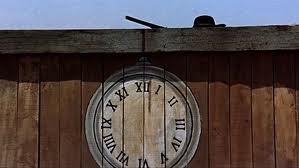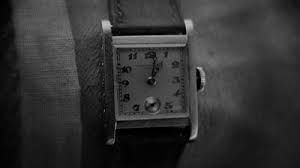FOUR VIEWS OF CHRISTIAN MARCLAY'S THE CLOCK
a roundtable of views
By Zoe Kravitz, Marcus Lee, Will Buhler & Kevin Lawrence
 |
| Time goes boom! |
Time: 10:00 to 10: 15 (in the morning)
Having no expectations before sitting down to watch Christian Marclay’s The Clock, I was more than pleasantly surprised to find that watching time pass by in movies was exceptionally more entertaining than watching it pass by in real life. Except for the fact that to watch the entire 24-hour film, I would have to spend 24 hours of real, never getting it back, precious hours, and yet, after my brief tenure with movie living I was pretty much convinced it would be worth the sacrifice.
Unfortunately, due to my pitifully sized bladder and the long line to get back in, I only had the chance to watch a mere 15 minutes. Or maybe it was the experience of being acutely aware of every passing minute that made me have to pee, but we’ll save that for an article on art and psychobiology. So during that brief time, I sat on a couch with two strangers and was so uncomfortably close to them that I experienced some serious thigh touching. I am not a fan of thigh touching, even for art.
 |
| Do you know this scene? |
The film was a mixture of movies from black and white, to foreign, to modern day blockbusters. Instead of a series of famous “Here’s looking at you, kid” shots, I found myself watching scenes I might have simply overlooked. It was the history of film composed of easily forgettable moments…and it was hypnotically alluring. I don’t know what this says about film or time, but in a strange way it changed my perception of both. Disorienting conversations would flow throughout the jumbled up, nonlinear and mismatched scenes. Tensions rose as a few men had a shoot out in an office. Or when another film had a man try to change the time by climbing on to Big Ben. And then there were the less white-knuckled scenes, like watching Paul Newman lie in a bed, beautifully, just lying there as the time passed. And finally the unexpected treat of recognizing a movie!
While experiencing The Clock you’re always aware that you’re participating in the act of watching, similarly to how the film itself is consciously aware of time. The purpose is not to forget or to vicariously live through the actors on screen, normal movie going, but to get closer to time, to feel it move and to know that it is always there. That’s really quite exciting. My only caution would be that watching time go by is a little anxiety inducing.
 |
| It's always there |
Marcus Lee
The Time: 12:52 -1:12 (in the afternoon)
I was at SF MOMA strolling around, minding my own business, thinking about art and the meaning of life when I happened to see a sign for The Clock and I thought to myself, “The Clock? What a fetching title,” and so I said to myself, “I have to go see this piece of art.” I didn’t really know what it was, but there were people in line and so I got in. That’s the rule in the Bay Area, you see a line and you get in it. I had seen a video installation some years before where you’re filmed and it gets played back in a thirty second delay, and so I thought this might be a more elaborate version of that. Who doesn’t want to be a star of a conceptual art work, if even for a moment?
 |
| I was confused and then I wasn't |
I went in and to my surprise, as you already know, The Clock, is a movie about time. It accomplishes this through interlacing hundreds of movie clips that depict the actual time that you are watching it. If it’s midnight in The Clock, it’s midnight where you’re watching it, although not midnight in Australia, but that’s a deeper question that The Clock doesn’t address. But it does kind of juxtapose all sorts of disparate images together and it’s a little bit like being in a twilight zone of cinema’s past. You see Tom Cruise in Mission Impossible checking his watch and then all of sudden Ralph Macchio and Mitchell Whitfield are sitting in a police station in My Cousin Vinny and in the background there is a small clock and yes! Yes! Yes! The time is correct in both instances, as it is for every instance of this elaborate stunt. A door opens in one clip and a woman walks her suitor into a house and in the next clip another women walks out with the mailman, closing the door. I guess you could get lost in each clip, enjoy how it transitions from one film to the next and all the while wonder where the next clock is going to show up, but that’s not what happened to me.
I have to admit, that as soon as it started, I started to think a lot about it. I was confused and wasn’t particularly giving myself over to the piece. Once I understood what was going on, I was interested for almost five minutes, and then I started thinking again about what was going on? What was the purpose of all this time? What does this really mean? What is this all about? Well, I don’t know what it’s about, couldn’t figure it out then and I don’t have a better answer now, but I know as soon as I ask that question I’m bored. I don’t want to ask questions about the art I see. I want to be totally immersed in it. So, to say that I was thinking about The Clock isn’t a compliment. I stayed for ten more minutes and left.
So The Clock, well, it’s intriguing and well done for what it is, but I definitely don’t want to see more. I guess I’ll have to leave the other twenty-three hours and forty minutes to my imagination.
Will Buhler
Time: Unknown, about an hour, during the day
 |
| Don't ask this guy the time |
I pretty much thought it was great. The Clock was pretty great. Just really great. Since I saw it a week ago, I often find myself day dreaming about what The Clock is doing right now, and who’s there, how it's doing without me. I guess you could say I have a new bff and this new bff (with apologies to my old bff) is a twenty-four hour piece of conceptual art. I’m a lucky boy and I know it.
You would think that in a piece such as this that what you experience would be very controlled, but what Christian Marclay creates is more like an opened-ended dream that allows or gives you time to find your own narrative. Depending on when you enter and exit the viewing you’ll be able to draw out various plot lines running through the hundreds of snippets of film that make up the piece. It's not what I expected at all, in my imagination that is. Before going I thought it was going to be minute long shots of clocks, one after the other, which sounds dumb and is, but that’s not what it was and it is anything but dumb. It was much more than I imagined because Marclay seems to understand how the imagination works. He understands that it’s limitless and that time is just one of the ways that we understand the imagination and, by implication, let it loose. I was completely wrapped up in the jumbled narrative unfolding before me. During one sequence, Marclay took us from car crashes and bank robbers to screaming drummer boys. The narrative is hardly consistent, but that’s what made it worthwhile. It’s that you have to take in this chronicle of time and make it make sense in your own way.
 |
| Time is not easy |
I should mention that what Maclay has done is not easy. The editing and the timing of the cuts, the flow of the piece, are amazing. If I didn't have to cut my trip short I easily could have spent a few hours there, mostly just trying to find some moment of closure in the continuous loop. I guess the best way I can express how much I liked it was that I’m going back. I'm not quite convinced that it's really as good as I think it is, but I’m definitely hooked. I'm somewhere between a smitten teenager and a junkie. That’s a nice place to be and so, you know, I just want to get my fix of time.
Kevin Lawrence
Time: 4:45-5:30 (in the late afternoon)
When my girlfriend told me that we were going to see The Clock, I was not happy. All I could imagine was a wristwatch in the middle of a screen, ticking away and my life with it. The next minute would then cut to a clock radio. Maybe the next a sun dial. I was cringing with the mere thought of this going on and on and just so pretentious hipsters could gloat over exactly how long they were there. God save me.
 |
| A Hipster Fantasy |
I knew this because I was standing in line surrounded by hipsters and old people waiting for hipsters and old people to leave so that we could enter and be surrounded by hipsters and old people. Sometimes it seems that conceptual art is made and marketed to hipsters and old people. When we finally get in we sit down on couches and much to my relief instead of watching clocks, we’re watching a narrative film (a very long one, but a film). At points there is actual rising tension and that tension, sorry for the vagueness but I don’t know what else to call it, rises through different film clips to one climax. It’s as if every film were the same film. We’re watching a western that’s in color and two men stare each other down and then the film cuts to a black and white film, but the cut works somehow and it all seems like the same narrative but it isn’t. Then all of sudden we cut back to the western and Clint Eastwood has joined the fray. Finally, we get a crescendo, a blitz of shots from the western and other films and this all goes on until one character is dead.
I enjoyed all this thoroughly and as we left I say to my girlfriend that we were there for 45 minutes and I look up and see some other guy with his girlfriend and I know what he’s thinking—“Fucking hipsters and old people, why am I here?” Well, to that I say, my annoyed friend, one day we’re all going to be old and so you might as well experience The Clock while you’re hip, or, at the very least, young.
 |
| Time is up! |
©CCA Arts Review and Zoe Kravitz, Marcus Lee, Will Buhler and Kevin Lawrence

No comments:
Post a Comment